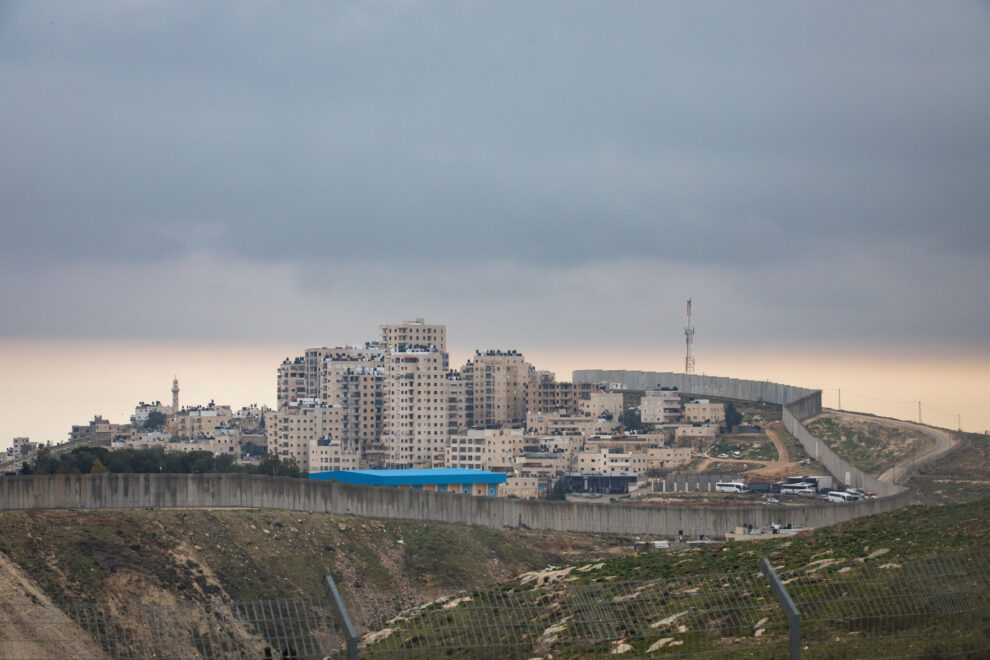Plans for 400 new homes inside a Palestinian neighborhood straddling the West Bank and East Jerusalem were given the go-ahead by the Jerusalem District Planning and Building Committee last week, paving the way for Israel to drastically expand a Jewish enclave in the heart of the town.
The proposal for a new neighborhood in Abu Dis, a Palestinian town sliced in half by the West Bank security barrier, was given the green light after the committee found that it had met threshold conditions for initial approval, the Times of Israel’s Hebrew sister site Zman Yisrael reported Sunday.
The proposal must still pass through more planning stages before construction and marketing can begin in earnest.
The proposed establishment of the new neighborhood was first reported in March by Zman Yisrael, along with plans to build or expand Jewish enclaves or neighborhoods in other parts of the capital.
Dubbed Kidmat Zion, the new neighborhood is set to be built on a large plot of land near the security barrier in Abu Dis that pro-settlement figures in Israel have eyed for years.
The town is currently home to about a dozen Jewish families who live in two small residential buildings purchased by a US benefactor, one of a number of small Jewish enclaves inside Palestinian neighborhoods in the city that are meant to signal Israel’s hold over the entire capital.
Unlike some other enclaves though, where Jews have historical claims, Abu Dis lies far outside what most would consider Jerusalem’s core municipal area and holds no special importance for Jews beyond having been partially included when the city’s borders were expanded following the 1967 capture of East Jerusalem. Former prime minister Ehud Barak planned to cut Abu Dis and two other neighborhoods out of the capital in 2000 as a gesture to the Palestinians but shelved the idea when the Second Intifada broke out that year.
The area holds strategic value, however, abutting a traffic artery being built along the eastern edge of Jerusalem that will link settlements south of the city to those in its north and east. The so-called American Road will include a tunnel beneath Abu Dis which will seemingly traverse the tract where the Jewish enclave in Abu Dis is being planned.
Most of Abu Dis is outside Jerusalem and within the boundaries of the West Bank’s Area B, where the Palestinian Authority has civilian control. Some 15,000 people live in the town, including prominent Palestinian leaders and academics such as Sari Nusseibeh. It is home to a university and a large Islamic college, as well as Palestinian government institutions.
Also in the town is the hulking shell of a nearly complete five-story building which had been slated to become the Palestinian parliament, per a 1995 agreement between future PA president Mahmoud Abbas and former Israeli lawmaker Yossi Beilin, a key architect of the 1993 Oslo Accords.
Palestinians claim East Jerusalem as the capital of their future state, but Israel considers the entire city its undivided capital and protests attempts by the PA to operate inside the city. Abu Dis, which sits both in East Jerusalem and outside it, had been suggested as an alternative. It was mentioned as a possibility as recently as the 2020 Trump Administration peace plan.
The building stands a short distance from the outskirts of the proposed Jewish neighborhood.
Despite the okay for the 400 new units, it is still possible the plan will run into opposition and be rejected or frozen due to political pressure. While Prime Minister Benjamin Netanyahu’s hardline cabinet overwhelmingly supports settlement building and expanding Jerusalem’s Jewish presence in Arab neighborhoods, the government has come under intense pressure from allies abroad to tamp down on actions liable to destabilize the region.
In 2000, planners gave an initial okay to 225 housing units in Abu Dis. But the plan never got a final okay from political authorities who need to sign off and it has sat unfulfilled since.
Right-wing groups see an opportunity
The new planned enclave will blend into Abu Dis’s urban fabric, killing any chances of the town being regarded as a suitable home for a Palestinian capital.
The scheme is being pushed by Ateret Kohanim, a well-funded far-right group that buys land to settle Jews in East Jerusalem, and an organization called the Tenants’ Association, which purchased land in Abu Dis as early as 1926.
In early 2004, Ateret Kohanim was able to purchase two buildings in Abu Dis with the financing of US millionaire Irving Moskowitz. Currently, 10 Jewish families live in three buildings in the village, two of which are called Beit Sarah (Sarah’s House) and Beit HaAchim (The Brothers’ House).
On Jerusalem Day last week, the group announced that it was working to “promote building permits for 400 housing units that will change the map of the eastern part of the city. The neighborhood sits in a strategic location, and can gradually change its image to Jewish and prevent the Arab takeover of the city’s eastern neighborhoods.”
“Palestinian institutions in Abu Dis were built with the vision of turning the town into the capital city of Palestine and building a corridor and passage to the center of Jerusalem, and thus promoting the takeover of the entire city,” the group wrote in an explanatory notes document filed with the committee.
“The significance of establishing and developing the neighborhood is to create a shield for Jerusalem against Palestinian ambitions. The neighborhood will disturb the contiguity [of the area] and protect us from dividing the city,” it said.
Senior right-wing officials in the Municipality of Jerusalem are convinced that the current government will advance the plan quickly, and will not delay it, despite the expected international reaction. The feared backlash has stopped previous governments even where there were also partners from the center and the left.
Aryeh King, the deputy mayor of Jerusalem and an Otzma Yehudit member, told Zman Yisrael: “I am sure that the current government, which today discussed the budgeting for [Route 4370, also known as] the Eastern Ring Road out of an understanding of its strategic importance for the future of Jerusalem, will also advance the Kidmat Zion neighborhood plan that is planned on the borders of [that route].”
(Route 4370 is a West Bank road with a physical barrier that separates Israeli and Palestinian traffic. The five-kilometer road, inaugurated in 2019, is divided down its length by a concrete wall topped with fencing. Two lanes of the road connect the Geva Binyamin settlement, also known as Adam, north of Jerusalem, to the city’s French Hill neighborhood — and are open to Israeli vehicles and to Palestinians who have entry permits for Jerusalem. The other two lanes branch off and lead around the east and south of the city, without access to Jerusalem itself, and are for vehicles of Palestinians who do not have access permits for Jerusalem.)
“This is our big opportunity and we will not give up on it,” another senior official told Zman Yisrael.
So far, Ateret Kohanim’s fundraising campaign has raised about NIS 800,000 (about $220,000) far above its initial goal.
On Sunday, the organization’s chairman, Matityahu HaCohen Dan, arrived at the cabinet meeting, held in the Western Wall tunnel, and talked with ministers and other officials there.
Source : Times of Israel































